Martin B-26 Maurauder, 44-68079, Gorey, Wexford
The townland of Killenagh, near Gorey in County Wexford in the
south west of Ireland, would have the honour of being the
location of the last aircraft landing involving an United States
Army Air Forces (USAAF) aircraft before the end of the war in
Europe. Reports were received by the military and police
authorities during the evening of 15th of February, 1945 that an
aircraft had come down in "Killenagh" or "Rahenmore" townlands,
a few miles south of the town of Gorey. The time of the
landing was noted by the Irish Army as 19:40 hours.
A party of officers and men from the 3rd Battalion, Irish Army, was dispatched from the Army post at Bawnjames in New Ross to the South West. Upon reaching the location the officers began to record the details of the landing. The aircraft was found to be a twin engine bomber type with the serial number 468079 on the tail. The wings, fuselage and propellers were all badly damaged from the landing. All guns on the aircraft were recorded as being covered in canvas and paper. This item would have been noted in an attempt to determine if the aircraft was engaged in active combat duties. While at this stage of the war in early 1945, there was very little chance that an Allied crew would find themselves interned, the military still made the effort to make the Irish governments policy on internment stand up. This covering on the aircraft's weapons also points towards the aircraft being on a ferry flight. On the transatlantic ferry flights one would expect to find the aircraft guns covered in this manner fresh from the factory.
The occupants of the aircraft were only two men. The two, members of the USAAF based in England gave their names to the Irish officers as 1st/Lt Kenneth D MACE, serial number O-745434, address: BAD2, Station 582, APO 635, England and Corporal James D Busser, serial number 13030699.
Lt. Mace told the officers that he had left Liverpool for
Scotland and lost radio contact, resulting in him becoming lost.
One of his engines then gave up and shut down and he was forced
to make the emergency landing with only 15 gallons of fuel left.
The Irish Army report however does go on to say that Lt Mace was
dazed from the crashed landing and later changed his statement
to say that he was flying from St Mawgan in South Wales to BAD
Liverpool. The BAD mentioned here and above in the address
indicates the USAAF, Base Air Depot Number 2, located at Warton,
in Lancashire. It was to this base and others that newly
delivered aircraft from America were directed after arrival in
Europe. Here they were prepared for combat duties by receiving
certain modifications to equipment that had been developed in
Europe after combat experience was gained on the various
aircraft types.
The two American's were taken from the crash site to Gorey town
and allowed to spend the night of 15th/16th February in the
Hotel Gorey. The Irish Army report indicates they were taken to
Baldonnel aerodrome on the 16th and though the report makes it
unclear, American reports transcribed below indicate that they
stayed another night at Baldonnel.
Colonel Hathaway, the US Military Attache in Dublin sent the
following telegram to Washington on the 16th February 1945.
B-26G sr nr 44-68079 force landed
wheels up 1920 hours Feb 15 vicinity Cahore Point County
Wexford without injury to crew of two pilot 1st Lt Kenneth
D. Mace, 0-745434 and Engr Cpl James D. Burser, 13030699.
Plane damaged severly crew being evacuated this date salvage
under way ETO notified.
The US Air Attache at the time Lt. Col. George E Sprague filled
a report on February 23 attached to a Military Attache Report,
R.6.45, to the Military Intelligence Division. The source
of the report was written as "Personal
observation and conversation with Crew members"
and went on to read, in a manner broadly similar to the consular
telegram above: B-26 Bomber, No.
44-68079, crashlanded at 1920 hours, February 15, 1945, at
Cloneven, County Wexford, without injury to crew, but with
major damage to aircraft. Crew, released from
internment, was evacuated to Northern Ireland, February 17,
1945, together with classified equipment and documents,
which Eire military authorities allowed them to retain in
their possession at all times. Wreckage being salvaged
and salvageable parts will be transported to Northern
Ireland."
Another sheet attached to the archive report from the US Air
Force Historical Support Office was an expanded version of
Sprague's report.
A B-26G bomber, No. 44-68079, crash
landed at 1920 hours, February 15, 1945, at Cloneven, near
Cahore Point, County Wexford, without injury to the crew,
Pilot, 1st Lieut. Kenneth D Mace, O-745434, and Engineer,
Corp, James D. Busser, ASN 13030699.
The crew members were released from internment on
February 17, 1945, evacuated to Northern Ireland by the
undersigned and turned over to the intelligence officer at
AAF Station 597, Langford Lodge, Northern Ireland, same
date.
The aircraft, which suffered major damage, is being
dismantled by the Eire Army Air Corps, and salvageable parts
and material will be transported to Northern Ireland.
The Eire military authorities allowed the crew to
retain in their possession all classified equipment and
documents, which they took with them to Northern Ireland.
The Eire military authorities established a guard about the
scene of the crash, and no civilians were allowed near the
wreckage.
Lieut. Mace was en route from St. Mawgan to Warton,
England on a ferry flight, and had been lost over Eire for
several hours, attempting a landing when one engine failed
and his fuel was exhausted.
Far the military attache"
From the above it becomes clear that the two men stayed two
nights in Ireland, which is a little strange compared to most
incidents of this nature where no injuries occurred. It
was more normal to find that men were brought to the border if
not on the day of the crash, but usually on the next full day.
And while Lt. Col. Sprague talks of the men being interned, the
same terminology is not used in the Irish report. At this
late point in the war, Allied crew members were not being
interned and not been since the Spring of 1943. It perhaps
was the impression the American's got when one reads Corporal
Busser's report in his local newspaper in York, Pennslyvania
some months later.
The return of the sadly battered aircraft, serial number 468079 would take a little longer. The report does not mention the aircraft type in much detail but the Irish officers, particularly those from the Irish Air Corps who were sent to Wexford would have been somewhat familiar with the type having helped in the salvage of two similar aircraft during the previous two years. The aircraft was a Martin B-26 Maurauder, medium bomber. The type was used extensively over Europe by the USAAF's Ninth Air Force in attacks on targets in the occupied countries, striking at bridges and rail targets for example. At this stage in the war, many of the B-26 units had transferred with their aircraft to the newly liberated France from their old bases in England to continue their campaign.
B-26 44-68079 found itself stuck on the land of John Earle of
Killenagh. Four trees were broken by the aircraft sliding to a
halt. It took sixteen days for the military, including a salvage
team from the RAF in Northern Ireland. The fields were in such
bad condition, it being winter, that they were forced to raise
the aircraft up onto its landing gear so that it could be towed
to a somewhat drier piece of ground. An Irish Army Bren Gun
Carrier had to be brought to the site to assist the recovery
effort. In the end, the remains of the aircraft were taken away
on a number of low loaders. The report concludes that a hundred
weight of aluminum was left by the side of road 'for anyone who
wanted it' and it was gone by the time the military had finished
at the scene.
The operations record book of the Royal Air Force's 226 Maintenance Unit based at Mallusk, Northern Ireland, recorded the following statement in February 1945: In addition, two special parties salvaged Marauder (American) 468079, collected propeller, guns and instruments from Liberator KK295, under the direction of F/Lt H S Moore HQ RAFNI
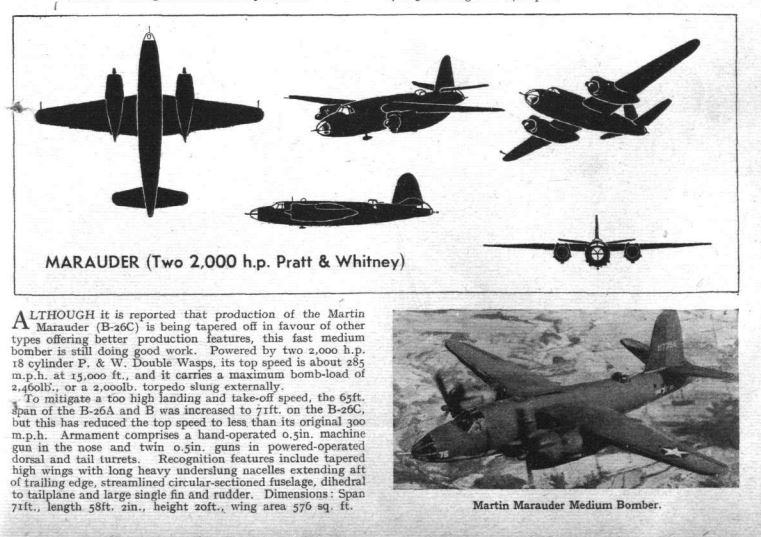 The Irish Army salvage
report does contain one example of the very dry language used in
these reports by Irish Army officers. In describing the removal
of an altimeter from the aircraft by either a local or a member
of the armed guard, he describes that the 'genius' who removed
it had dissembled it in such a manner that "neither he nor the makers would ever be
able to put it back together".
The Irish Army salvage
report does contain one example of the very dry language used in
these reports by Irish Army officers. In describing the removal
of an altimeter from the aircraft by either a local or a member
of the armed guard, he describes that the 'genius' who removed
it had dissembled it in such a manner that "neither he nor the makers would ever be
able to put it back together".
The serial number on the aircraft indicates it was a Martin
B-26G-20-MA Marauder. The G model Marauder was introduced in
March 1944 and this aircraft was among the very last Marauders
built. The aircraft was built in the Martin factory in
Baltimore, Maryland. The aircraft serial number was 44-68079,
but was painted as 468079 on the tail in common with USAAF
procedures at the time. The image shows a 1944
aircraft recognition article from the February 3rd, 1944 edition
of Flight magazine published in the UK.
Local historian Owen Dunbar has over the years gathered the
local stories of the days excitement. I travelled out to the farm where it came
down and spoke with John Earl 80 son of John Earl who
witnesses the crash in 1945. John told me the story as told
to him by his father who was ploughing on the day with a
team of horses one young and an older horse. He said the
noise of the low flying aircraft scared the young horse so
much that it bent part of the plough trying to get away from
the aircraft. The plane clipped the tops of a grove of oak
trees they are still there today. Another story he told was
that the plane was leaking oil so his father went with a
bucket and placed it under the drip he wasn't there too long
when a Garda rode up on a bicycle and told him to clear off
and the he wasn't to go within 200 yards of the plane. I
then asked John if he had ever found anything of the plane
in the intervening years he said the only thing he had was
an (indicator) light cover think he meant and navigation
light glass cover which he showed me.
And so what of the two crew members from this stricken
bomber? It was being flown by a pilot who was assigned to
a Ferry Squadron. The other man on board was a maintenance
engineer who occasionally flew on maintenance flights as an
Aerial Engineer.
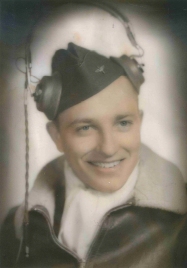 |
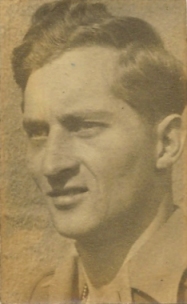 |
| 1/Lt Kenneth D MACE O-745434 | Cpl. James D Busser 13030699 |
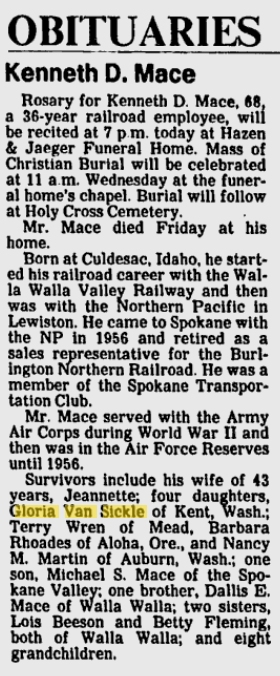
Kenneth Dean Mace was born in CuldeSac, Idaho on the
14th of September 1921 to Lizzie and Victor Mace. He enlisted in
the USAAF in April 1942 in Seattle, Washington gaining the
enlistment number 19094957. During his training he suffered a
landing mishap in a Vultee BT-13 trainer at Toyah Field in
Texas. Upon completion of his training, he was commissioned and
obtained the officers serial number O-745434.
He served overseas from 17th October 1943 to the 8th
December 1945. His statement of service at the wars end
summaries his wartime service as: "PILOT,
FOUR ENGINED -- Served in the European Theatre of Operations
with the 8th Army Air Forces. Was a member of a ferrying
Squadron with the Air Service Command. Flew first line
aircraft from supply bases to combat using units. Operated
out of bases in England and Ireland, delivered aircraft to
and from France, Scotland, German, Africa and Italy. Has
1160 hours of flying time.". In April 1945 he had
a taxing accident in a B-17G Flying Fortress bomber on a Ferry
mission at Stansted airfield in England. His last recorded
flight was on the 3rd of December 1945 when he was co-pilot on a
C-47B Skytrain. Kenneth's return from Europe was on board the
Queen Elizabeth liner in December 1945. He appears on that
vessels manifest sailing with officers and men on a roster of
the 36th Bombardment Squadron (Heavy) RCM. The RCM in this case
signifying that this unit was involved in Radio Counter
Measures, or early electronic warfare. It may be that Kenneth
was rostered in for administrative purposes during the
demobilization process after the war. His family including
daughter Gloria were kind enough to share their memories of his
wartime duties. It is their understanding that he mainly flew
aircraft like B-26 44-68079, those that were after being
delivered from the United States and those being ferried to and
from maintenance visits. These stories, including that of the
Irish landing were known to the Mace family after the war.
Kenneth's father Victor served in the US Navy's SeaBee's
Contruction Battalions in Hawaii during the war and his brothers
Dallis and Keith also served in the armed forces.
The photos below of Kenneth show him, at right standing on the wing of a P-51 Mustang with the earlier, non bubble canopy. The middle photo show him standing in front of a Republic P-47 Thunderbolt with nose art bearing the name 'Lillput'. This artwork was carried by aircraft flown with the 334th Fighter Squadron of the 4th Fighter Group out of Debden airfield in England. One of the units pilots, William B Morgan carried these markings on at least two Thunderbolts, serials 42-7919 and 42-8644.
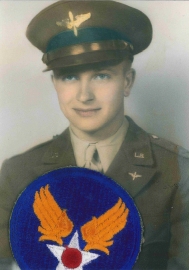 |
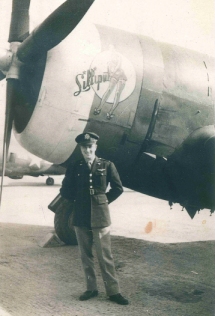 |
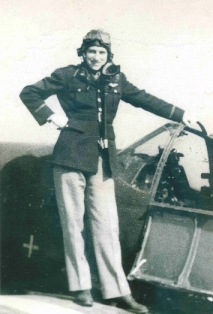 |
His post war life brought him to Spokane, Washington and his
obituary printed in the Spokane Review is presented above.
Kenneth met his wife in France at the wars end, with Kenneth
returning to Europe in September 1946 and they married in Paris
in December that year. The couple arrived in America in
the following year and they lived in Spokane, raising their
family.
Kenneth passed away on the 12th of January 1990.
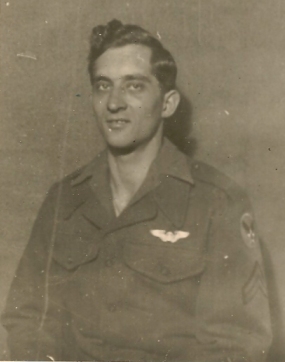 James
Busser was born in October 1918 in York, Pennslyvania. His
enlistment details indicate that he joined the Army Air Forces
in August 1941, prior to the war beginning. His occupation at
that time was in the area of machine shop activities which seems
to fit in with him being a maintenance technician during the
war.
James
Busser was born in October 1918 in York, Pennslyvania. His
enlistment details indicate that he joined the Army Air Forces
in August 1941, prior to the war beginning. His occupation at
that time was in the area of machine shop activities which seems
to fit in with him being a maintenance technician during the
war. 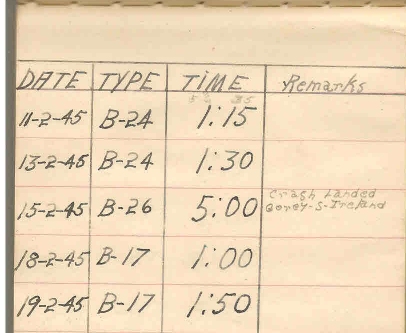 On
the 1940 US census, he is recorded living at home with his
parents Cecila and James Sr. and working with his father in the
dental supplies industry.
On
the 1940 US census, he is recorded living at home with his
parents Cecila and James Sr. and working with his father in the
dental supplies industry.
BAD #2 Morning Reports records his promotion to Corporal in May
of 1944.
His local newspaper, the The York Despatch, from that town in
Pennsylvania, published numerous short news updates about his
wartime activities throughout 1941 to 1945. They reported
on his progress from training at Chanute Field, Illinois and
Mobile, Alabama during 1942, to landing in the UK in late August
1942. He wrote to his parents in October 1942 to say he
was being posted to Northern Ireland for duty in aviation
repair. December 1944 finds him reporting home that he had
been awarded the status of flight engineer for maintenance
purposes.
They published the following curious story from James upon his
return home in September 1945:
ESCAPED FROM EIRE
Flight Engineer James D. Busser, Jr., Finds
Way to English Base After Plane Crashes
After more than three years over-seas Corporal
Flight Engineer James D. Busser, Jr., son of Mr. and
Mrs. James D. Busser, 517 West Jackson street, has been
discharged from the army. He served with the Eighth Air
Force which had been designated for overseas duty against
Japan before the latter's capitulation. Stationed at
Blackpool, Eng., the, York airman's plane crashed in neutral
Eire when he and his pilot became lost and their gasoline
supply was exhausted in a practice flight across the Irish
sea.
Through an underground system Flight Engineer Busser
and his pilot were taken into the home of an Eire farmer,
who provided for them until their contact assisted them to
the Ulster border, where fellow American soldiers returnede
them to their post.
Corporal Busser witnessed one of the London "blitzes"
and also saw the demolished and wrecked home of the late
Fuehrer Adolf Hitler at Berchtesgaden. He visited the Rhine valley and also made
flights and tours, while on leave, to Morocco, the English countryside, Paris, Naples and
other points of interest in Africa.
It is curious in that even at that late stage in the war, he
must have felt compelled following his debrief to maintain a
tale of secrecy to cover the direct assistance given to Allied
airmen by the Irish Army.
His daughter Sandra related how he didn't speak much of his wartime career and she felt that he had thrown away most of his wartime memorabilia upon his return home. She did know however that he had been on an aircraft that landed in Ireland. She most remembers him speaking about B-17 bombers and that he used to work on them and sometimes fly in them. He left behind a small note book in which he recorded his flights including the one that brought him to Ireland. James had enlisted prior to the attack on Pearl Harbour and served overseas in the UK from August 1942 to September 1945. James finally attended a reunion in Blackpool, England in the early 1980's. James moved to Arizona after the war and died there in 1990, only 12 days after Kenneth Mace, his pilot on that day back in 1945.
Compiled by Dennis Burke, 2025, Dublin and Sligo. With thanks too the Mace and Busser families for their kind help.
